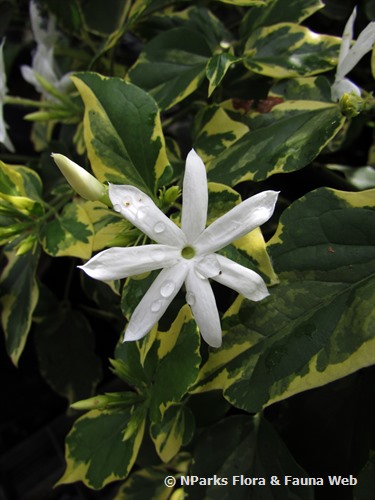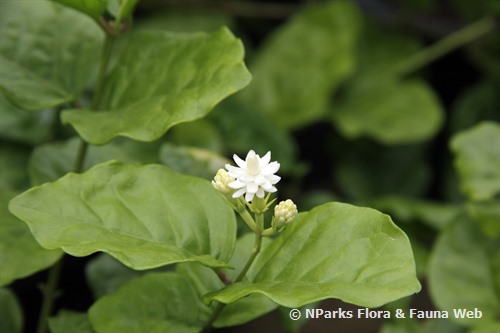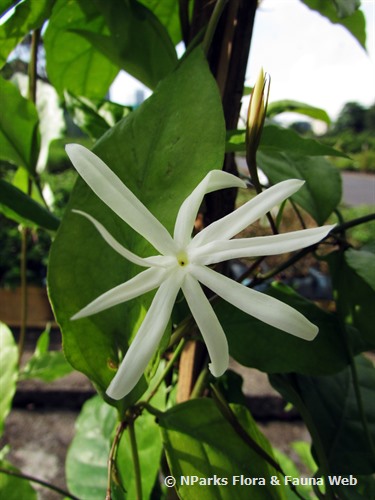
Back
Jasminum laurifolium Roxb. ex Hornem.
| Family Name: | Oleaceae |
| Synonyms: | Jasminum laurifolium var. genuinum, Jasminum angustifolium var. laurifolium |
| Common Name: | Angel Wing Jasmine |
Name
Classifications and Characteristics
| Plant Division | Angiosperms (Flowering Seed Plants) (Dicotyledon) |
|---|---|
| Plant Growth Form | Climber, Shrub |
| Lifespan (in Singapore) | Perennial |
| Mode of Nutrition | Autotrophic |
Biogeography
| Native Distribution | Indian subcontinent, Myanmar |
|---|---|
| Native Habitat | Terrestrial |
| Preferred Climate Zone | Tropical |
| Local Conservation Status | Non-native (Horticultural / Cultivated Only) |
Description and Ethnobotany
| Growth Form | Evergreen shrub with a scandent growth form, able to grow up 6 m tall. |
|---|---|
| Foliage | Dark green leaves are oppositely arranged, coriaceous and 3-nerved, measuring about 6 cm long and 2 cm wide. |
| Flowers | 3 - 5 flowers are borne on terminal cymes, the flower calyx is long and linear, corolla has a white inner surface while outer surface is usually red, corolla lobes are linear-lanceolate with an acuminate apex. Usually has 9 - 11 petals with very narrow sepals held at right angles to the corolla tube. |
| Cultivation | Plant can be grown via stem cuttings of at least 5 cm long, bearing at least one pair of leaves and cut beneath a node (the leaf joint). If the leaves are large, reduce the leaf size to avoid wilting, to allow roots to be developed. Use of rooting hormone will aid rooting process to about one month. Once well rooted, young plants can be potted into suitable compost and kept in slight sheltered position to allow establishment and ready for planting . Plants can be pruned regularly to promote bushier growth. |
| Etymology | Genus Jasminum is derived from the Persian name yasemin, which is for perfumed plants. Species epithet laurifolium means laurel-leaved. |
Landscaping Features
| Landscaping | Numerous star-like flowers with narrow petals makes the plant suitable for tropical-themed gardens and informal hedge. |
|---|---|
| Desirable Plant Features | Ornamental Flowers, Fragrant (Flowers) |
| Landscape Uses | Parks & Gardens, Small Gardens |
| Thematic Landscaping | Fragrant / Aromatherapy Garden |
Fauna, Pollination and Dispersal
| Fauna Pollination Dispersal Associated Fauna | Butterfly-Attracting (Flower Nectar) |
|---|
Plant Care and Propagation
| Light Preference | Full Sun |
|---|---|
| Water Preference | Moderate Water |
| Plant Growth Rate | Fast to Moderate |
| Rootzone Tolerance | Moist Soils, Well-Drained Soils |
| Diseases | No signs of potential diseases. |
| Pest(s) | Chewing Insects |
| Propagation Method | Stem Cutting |
Foliar
| Foliage Retention | Evergreen |
|---|---|
| Mature Foliage Colour(s) | Green |
| Mature Foliage Texture(s) | Glossy / Shiny |
| Prominent Young Flush Colour(s) | Green |
| Young Flush Texture(s) | Glossy / Shiny |
| Foliar Type | Simple / Unifoliate |
| Foliar Arrangement Along Stem | Opposite |
| Foliar Attachment to Stem | Petiolate |
| Foliar Shape(s) | Non-Palm Foliage (Lanceolate) |
| Foliar Venation | Pinnate / Net |
| Foliar Margin | Entire |
| Foliar Apex - Tip | Acuminate |
| Foliar Base | Rounded / Obtuse |
Floral (Angiosperm)
| Flower & Plant Sexuality | Bisexual Flowers |
| Flower Colour(s) | White |
|---|---|
| Flower Texture(s) | Smooth |
| Flower Grouping | Cluster / Inflorescence |
| Flower Location | Terminal |
| Flower Symmetry | Radial |
| Individual Flower Shape | Tubular |
| Inflorescence Type | Cyme |
| Flowering Period | Free-Flowering |
Image Repository
Others
| Master ID | 141 |
|---|---|
| Species ID | 1437 |
| Flora Disclaimer | The information in this website has been compiled from reliable sources, such as reference works on medicinal plants. It is not a substitute for medical advice or treatment and NParks does not purport to provide any medical advice. Readers should always consult his/her physician before using or consuming a plant for medicinal purposes. |





